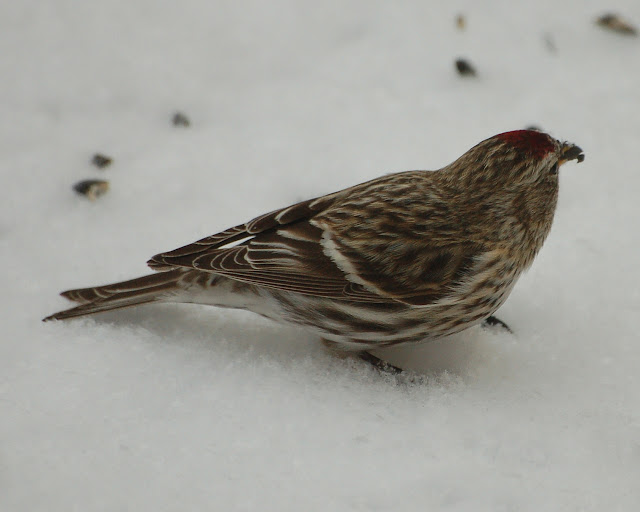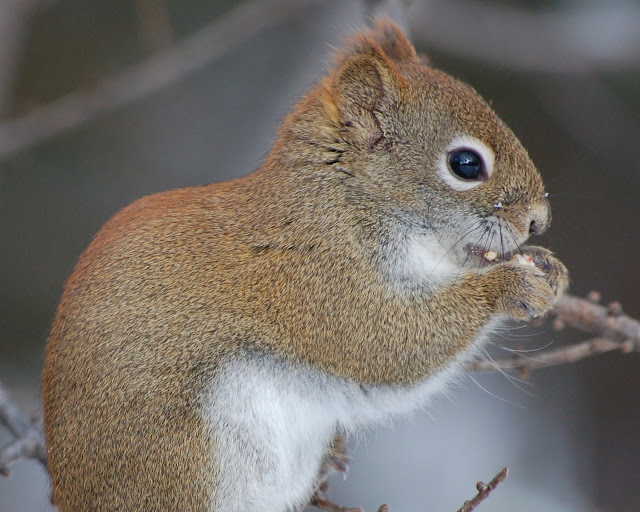The day before we had the good fortune to bump into a group of birders, Including Michael and Susan Kielb as well as Roseann Kovalcik, in Hubert Bog whilst looking for Gray Jays. I not only received some great local info from the group that landed me my lifer Red Crossbills, but also a fun evening of wine and fine conversation, and most importantly a very generous offer to visit their cabin early the next morning to watch their feeders and hopefully see one of the Hoary Redpolls that had been regularly visiting. "The Bruce" and I headed out early the next morning to take full advantage of the unexpected generosity of the Kielb's. We were greeted with coffee (bless their hearts) and an armchair view of the feeders below. While we started sifting through the larger numbers of Redpolls feeding outside we revisited our discussions on Redpoll ID, Michael assuring me that at least some of the Hoary Redpoll individuals were unmistakable once seen.
At first, not surprisingly, my experience was much the same as the day before. Hundreds of Common Redpoll, exhibiting an incredible degree of variability to my eye. It was a real treat to be able to just sit and observe the birds from such a great vantage point. There is nothing like simply observing hundreds of individuals when you are struggling with an ID problem, experience with a species really does count for something. There is really is only so much that can be captured with one page of a field guide, and to move beyond that you have to get out and observe and internalise the variation yourself. I wasn't seeing any sign of Hoary Redpolls but it already felt much more productive than my attempts to study them yesterday. Redpolls are not a species I've had more than a few fleeting views of before so this was actually a real treat, and today I was thankfully able to see it as such.
They are quite subtle birds, dull looking at first glance, but quite attractive in truth. The males are easy to spot with their rose-washed breasts.
 |
| Male Common Redpoll |
The females looking surprisingly like Pine Siskins wearing a fez.
 |
| Female Common Redpoll |
Occasionally, a frostier looking individual would stand out, tantalising me with it's potential to be a Hoary Redpoll. This one, may or may not have been. I needed to see more features before I was convinced, this was was frosty looking but the streaking on the sides looked fairly heavy, but certainly less than those around it. I really hate these heavily subjective field marks, at least until I have a handle on them.
The bird on the bottom right was another good candidate to my eye, I really would have liked to see its rump (that's what she said). If I was a betting man I think I'd be inclined to think this bird was a good Hoary, but at the time and for my first confirmed sighting I wanted a better, more convincing look.
Another Hoary tease, teasing.
Still, it really wasn't wasted time. If I wasn't trying so vary hard to turn each individual into a Hoary Redpoll, I would not have looked so carefully or appreciated the variation half as much. These amenable individuals were nicely displaying the streaking expected for a typical Common Redpoll on the rump and vent.
Finally, an individual appeared, and it was love at first sight. I don't care if it was Hoary, I loved it. It was extremely frosty, what I could see of the rump and sides seemed pale and at most lightly streaked. The description of Hoary Redpolls looking like they have been punched in the face was also a good match to this bird. I couldn't see the vent, but I was pretty sure I could sweet talk the bird into giving me a quick flash.
That rump does look nice and clean (the expectation for a Hoary), but a nicer look would be nice.
Oh yeah, that's what I'm talking about, that's the money shot.
There's the final view I wanted to see, a nice unmarked vent. Finally, an ass shot of a bird that is not frustrating, it had to happen one day.
 |
| Hoary Redpoll |
Finally, and reluctantly, we bid our new friends farewell and headed out to continue our explorations of the eastern UP. After not finding any Boreal Chickadees or Evening Grosbeaks at the feeders at Whitefish Point I moved on to failing to spot any Spruce Grouse down nearby Vermillion Rd. Not finding three for three birds turned out to be thirsty work and I was keen to visit the Tahquamenon Falls Brewery for lunch so we headed in that direction next. I was still scanning the sides of the road hoping for a rogue Spruce Grouse, none were forthcoming but I did spot more Red Crossbills eating grit from the road ahead.
Using advanced stealth techniques I was able to get close enough that you can, perhaps if you squint, just make out that that they are indeed Red Crossbills in the following photos.
Eventually, stealthy as I was, the birds flushed, giving me much better views and twittering their odd rhythmic calls.
 |
| Red Crossbill |
 |
| Hairy Woodpecker |
 |
| Pileated Woodpecker |
 |
| Tahquamenon Falls |
Finally, long after my stomach had started to drown out the sound of the Pileated, it was time for lunch. Some hearty food and a fine ale was just what the doctor ordered. Literally in this case. Bruce, got distracted trying to remember how to turn his phone on, bless him.
While Bruce battled with denial over the local cellphone coverage I turned my attention the birds at the feeder there. Nothing too unusual, but with a beer in my hand chickadees and nuthatches are more than enough to keep me happy. Eventually Bruce managed to tear himself away from facebook and pointed out how to sex the nuthatches. Sheepishly, not having noticed the species showed any sexual dimorphism, I even listened to what he had to say. The following White-breasted Nuthatch is a male, for example, the jet black cap would be a more frosty grey/blue colour if the bird had been a female.
 |
| White-breasted Nuthatch |
 |
| Red-breasted Nuthatch |
 |
| Black-capped Chickadee |
Dr Doolite can suck it, I'm the birdman around here.
I'm afraid that as a result my affection for the humble chickadee was rekindled and as a result I'm going to bombard you with a large number of photos of the little sprites. Deal with it.
It really is much quicker to write blog posts when I just include tons of photos and don't bother to write anything. Genius, I'm going to do it again, but this time with a Red Squirrel, another animal I have a soft spot for.
 |
| Red Squirrel |
 |
| Snow Bunting |
 |
| Snowy Owl |
 |
| Snowy Owl |
Although, I couldn't resist taking Bruce for dinner at a little dive bar I'd discovered previously. It had his name written all over it.
You know you've made a good choice when there is a deer skull nailed to the ceiling, at least that's what my pa always used to say.






























































Well worth the wait, this is a terrific post! You've reminded me how much I love the winter birds here in Minnesota. I have yet to see a Red Crossbill. I was lucky to have a Hoary Redpoll visit my balcony at Hasty Brook in northern Minnesota last winter. Love Redpolls. Great photos and plenty of words.
ReplyDeleteFinally
ReplyDeleteGreat post not so sure about those rather --y binocular body straps ;-)
An enjoyable post Mark. And don't let him tease you about your very attractive binocular harness. Love the photos of you and the chickadee. :) :) :)
ReplyDeletefantastic post and well worth the wait :) super photos
ReplyDeletedan
Totally wonderful, cool, educational & humorous! You are the birdman!
ReplyDeleteWOW This IS a huge blog post... almost too much to take in at once. But I have to say that i loved the shots of the Chickadee and the Woodpecker. Stunning shots indeed. ;-)
ReplyDelete